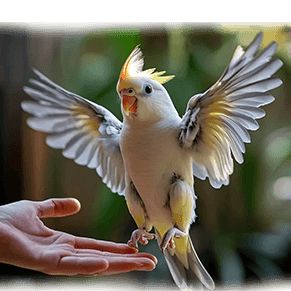How to Train Lovebirds: Building Trust and Bonding
Lovebirds are intelligent, social birds known for their playful and curious personalities. Training your lovebird can help strengthen your bond, provide mental stimulation, and ensure a happier, healthier pet. While lovebirds can sometimes be a little more stubborn than other birds, with patience and consistency, you can train them to become loving companions.
Understanding Lovebird Behavior
Before you begin training, it’s important to understand the unique behavior and temperament of lovebirds:

- Social Creatures – Lovebirds thrive on social interaction. Whether they have a mate or not, they need plenty of attention from their owner to prevent loneliness.
- Curiosity and Playfulness – These birds are naturally curious and playful, which can make training a fun activity for them.
- Stubborn but Trainable – Lovebirds can be independent and stubborn, but with consistency and gentle guidance, they can learn quickly.
Step 1: Establish Trust
The foundation of training a lovebird is building trust. A bird that trusts you will be more likely to engage in training activities.
- Spend Time Nearby – Start by sitting near their cage without interacting with them. Let them get used to your presence.
- Talk to Them Softly – Speak to your lovebird in a soft, calm voice to help them feel comfortable around you.
- Hand-Feeding – Offering treats from your hand can help build a positive association. Millet or small fruit pieces work well as treats. (Amazon affiliate link)
Step 2: Start with Basic Training – “Step-Up” Command
One of the most basic and important commands to teach your lovebird is “step-up,” which trains them to climb onto your hand or a perch on command.
- Use a Perch or Finger – Hold a perch (or your finger) near their chest and gently encourage them to step onto it. (Amazon affiliate link)
- Say the Command – As you bring the perch or finger to their chest, say “step-up” clearly.
- Reward Immediately – The moment they step up, give them a treat and lots of praise. Repeat this process daily until they respond consistently. (Amazon affiliate link)

Step 3: Target Training
Target training is useful for teaching your lovebird to move towards or follow an object. This can be great for mental stimulation and can lead to trick training.
- Choose a Target – Use a small stick or target wand. Present it to your lovebird.
- Reward Curiosity – As soon as your lovebird touches the target with its beak, give them a treat and praise.
- Guide Their Movement – Use the target to guide your lovebird onto different perches or to step up onto your hand.
Step 4: Bonding Through Trick Training
Once your lovebird is comfortable with basic commands, you can introduce fun tricks. Training tricks strengthens the bond between you and your bird while keeping them mentally engaged.
- Teach “Wave” – Once your bird has mastered “step-up,” you can teach them to wave by lifting their foot slightly and rewarding them.
- Spin or Turn Around – Use the target to guide your lovebird in a circle on a perch or your finger. When they complete the spin, reward them immediately.
- Retrieve Small Objects – Some lovebirds can be trained to pick up small objects and bring them back to you. Start with lightweight items like paper balls or small toys.

Step 5: Potty Training (Optional)
Potty training a bird is possible, but it requires patience and consistency.
- Observe Their Behavior – Birds often have predictable body language before they poop. Watch for signs like tail movement or a squat.
- Use a Command – When you notice the signs, move your lovebird to a designated area (like a perch or cage) and say a specific command, such as “go potty.”
- Reinforce with Treats – Over time, your lovebird may start to associate the location or command with the action.
Tips for Successful Training
- Short Sessions – Lovebirds have short attention spans, so keep training sessions to around 5-10 minutes. Multiple short sessions are better than one long session.
- Consistency – Train your bird daily to reinforce the behaviors you want.
- Patience and Positivity – Never punish or yell at your lovebird for not performing a command. Instead, remain calm and patient, rewarding progress.
- Respect Boundaries – If your lovebird seems stressed or uninterested, give them space and try again later.

Dealing with Behavioral Issues
Training can also help manage common behavioral problems in lovebirds, such as biting or excessive vocalization.
- Biting – Lovebirds sometimes bite out of fear or frustration. When this happens, avoid reacting negatively. Instead, calmly place them back in their cage for a break and resume training when they’re calm.
- Excessive Chirping – Lovebirds are naturally vocal, but if they chirp excessively for attention, avoid reinforcing the behavior. Only reward calm, quiet moments.
- Books like “LoveBird Handbook: Everything on caring and training your lovebird including detailed knowledge on behavior, grooming, health, feeding, breeding, enrichment, and lots more” (Amazon affiliate link) by Jonas Wootton are a great starting point for new parrot owners.
Building a Lasting Bond
Training isn’t just about teaching commands—it’s about building trust and forming a lifelong bond with your lovebird. By investing time and patience into their training, you’ll create a deeper connection with your bird, and they’ll become a more confident and well-behaved companion.
Final Thoughts
Training lovebirds takes time, consistency, and patience, but the results are well worth the effort. Whether you’re teaching basic commands or fun tricks, the key is to maintain a positive, rewarding environment. Your lovebird will not only learn new skills but will also grow closer to you in the process.
Affiliate Disclosure
This post may contain affiliate links, which means I earn from purchases made through links. Please see the privacy policy page for more details.





